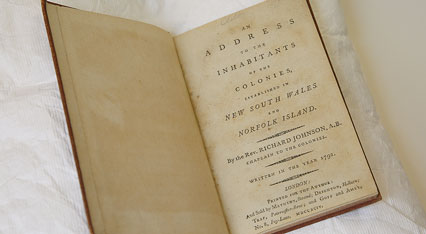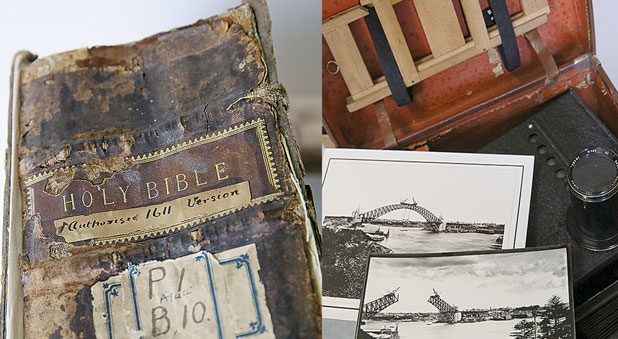A campaign has begun to preserve a major collection of Australian Christian history at the library of Moore College, including two of the first books ever printed by press, the first book distributed in Australia, an ancient Hebrew parchment, a first edition of the King James Bible and rare photos of the building of the Sydney Harbour Bridge.
The historic, and eclectic, group of “treasures” is to be housed and exhibited in the college’s new library, due for completion in 2017, and the college is raising funds to display and preserve the irreplaceable collection.
“Some of Australia’s priceless national heritage is found in the Moore College library – not surprising, since the college is one of the oldest tertiary educational institutions in the country and it became the repository of special books and artefacts from the earliest days,” said Moore’s former principal Dr Peter Jensen, who is backing the effort to conserve the treasures.
One of the most historic items of Australiana is “Address to the Inhabitants of the Colonies” by the chaplain of the First Fleet, the Rev Richard Johnson. It was printed in England in 1794 with editing by the slave trader-turned evangelist John Newton. Johnson used it in his work in Sydney, making it the first book conceived and distributed in Australia.

The collection houses many iconic pieces from the first years of the colony, including a volume of Cook’s Voyages (1785) and one of the few books which arrived on the First Fleet: a concordance given to Richard Johnson by a member of the Clapham Sect, the evangelical group which included William Wilberforce and is credited with founding the British and Foreign Bible Society and the Church Missionary Society.
Johnson passed the book on to his successor the Rev Samuel Marsden. The library holds 98 of the second chaplain’s handwritten sermons and, as Marsden was the first missionary to New Zealand, there is also an early Maori New Testament.
“Friends in England wanted to ensure that the infant church in NSW was provided with the resources of the Christian tradition and they gave generously,” Dr Jensen said. “So our library links us directly with such famous leaders as Newton, Wilberforce, Henry Venn and John Henry Newman. In fact, it contains about 70 books from the very first lending library in Australia.”
There are various papers and artefacts from elsewhere in the South Pacific, including some possessions of the Rev Charles Godden, killed in Omba (now in Vanuatu) in 1906, the first graduate of the college to be martyred.
As well as Australiana, significant pieces of ancient and Reformation history will be housed in the new library. There is a Hebrew parchment used by Deaconess Sophie Newton, who was a CMS missionary in China in the early part of the 20th Century. The fragment was rescued from a synagogue in Jerusalem in 1922. Reformation documents include a Greek New Testament from 1549, a Hebrew Bible from 1608, a first Book of Common Prayer (1549) and a first edition of the 1611 King James Bible (pictured), famous for a mistake in printing in Ruth 3:15, where “she” is incorrectly printed as “he”.
Highlights of the collection include Augustine’s City of God (1473) and Epistles of St Jerome (1487). They are known as incunabula, books printed during the cradle period of Western printing.
Among the more modern-day artefacts are the photos taken by the Rev Dr Frank Cash, who was rector of Christ Church, Lavender Bay while the Sydney Harbour Bridge was being built. As a keen amateur photographer, Dr Cash documented the construction of the bridge in more than 10,000 photographs. In the collection is his camera, many of the glass slides he made as well as two rivets from the bridge given to him at its completion (see picture).
“The collection reflects not only the history of NSW, but of Christian history from the early days of printing,” Dr Jensen said. “It is a heritage which belongs to us all and it is our responsibility to display and protect it.”
A donation facility is available through a website which gives background to all the objects. See treasures.moore.edu.au
















